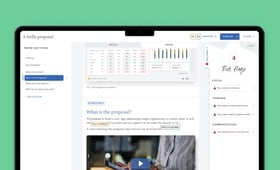When board papers miss the mark, everyone involved in the board reporting process suffers.
Directors get papers that don't answer their questions. Company secretaries spend hours managing review cycles and chasing revisions. Report writers do their best, but without a clear brief they're left guessing what the board wants to see.
This pattern plays out time and again, wasting time and causing frustration. Yet it's entirely avoidable, if you start the process with a high-quality brief.
The briefing gap: what the data reveals
Research we've conducted with the Chartered Governance Institute UK & Ireland shows that structured briefs make a dramatic difference to paper quality. When report writers are given a structured brief for their board reports, 64% of directors rate their board packs as "good" or "excellent". When they don't, only 12% of directors give their board pack a positive rating.
Yet despite this clear evidence, most organisations aren't equipping management with this simple tool. Only 49% provide a brief to management that goes beyond stating the title of the paper and the deadline.
The result is widespread dissatisfaction with board materials. In 2025, 61% of board packs were rated "weak" or "poor" and less than half of directors said their packs added value to board discussions.
The data suggests what might be missing from those briefs. 67% of directors think their packs are too internally focused, paying insufficient attention to the external context. 59% regard their papers as too operational at the expense of strategy. 64% believe they don't reflect the organisation's priorities.
Without a clear brief, report writers are guessing what to include. The result is too much of the wrong information, or not enough of the right information. And before you know it, you're either cycling through multiple review rounds or presenting the board with something that doesn't meet the mark.
The hidden cost of getting board paper briefs wrong
Poor briefing is as costly as it is frustrating.
Research shows that the average organisation spends £3.1 million on board reporting each year, equivalent to 3,580 working days. Writing board papers accounts for £2.7 million of that total, consuming more than 3,300 working days annually.
When briefs are unclear or missing altogether, those costs balloon and it's easy to see why. Report writers produce drafts that miss the mark. Reviewers send them back for another round. Senior executives spend hours wordsmithing them. Everyone loses time that could be spent on strategy, execution, or innovation.
What's more, board packs are now 24% longer than they were in 2019, now averaging 228 pages. Committee packs have increased 33% to 128 pages. More pages mean more time writing, more time reviewing, and more time for directors to read and digest. All of this makes the case for better briefing even stronger: if you can help writers focus on what matters from the outset, you reduce the volume, improve the quality, and save everyone time.
Board paper briefing best practices
A structured brief does more than set a title and deadline. It gives the report writer everything they need to deliver what the board requires.
Start by clarifying what purpose you need the paper to serve. Does the board need this information to make a decision or do they simply need to be aware of its contents? This shapes everything that follows in the paper.
Next, outline the context and constraints. Where does the paper sit in the chain of decision-making and governance? What's happened previously on this topic? What decisions have already been made? What are the key considerations the board should keep in mind? What's off the table?
Then, specify the questions you need answered in the paper. Rather than asking for "an update on Project Indigo", ask for answers to specific questions: What progress have we made against plan? What risks have emerged and how are we responding to them? What decisions do we need to make now?
The brief should also prompt writers to provide balanced analysis —filling the gaps that make it hard for directors to steer and supervise effectively. Encourage them to share the good news, the bad news, and the uncertain. Require them to consider the external perspective as well as the internal one. Ask for their insight: what does this information mean for the organisation? What should we do about it? What happens if we don't act?
Finally, provide practical guidance. Point them to methodologies that can help them structure their questions, like the QDI Principle, or relevant templates to help them organise their thinking. Give them a word or page count. Let them know who else might be reviewing the paper and when.
Crucially, allow the briefing process to become a dialogue. Encourage paper writers to come back with questions. Give enough time to redraft your brief if necessary. The upfront investment pays dividends in the quality of the first draft.
Structured report briefs: at a glance
|
Element |
What to specify in your brief |
|
Purpose |
Why does the board need the information in this paper? What are they going to need to do with it? |
|
Context & constraints |
Help the writer put the paper in context. Where in the chain does this paper sit? What's happened previously on this topic? What decisions have already been made? What's off the table? What are the key considerations? |
|
Specific questions |
Be crystal clear about the questions you want the writer to answer. For example: What progress have we made against plan? What risks have emerged? What decisions do we need now? What are the implications for our strategy? |
|
Balanced analysis |
Prompt writers to cover all the bases — good, bad, and uncertain. Ask for their insight: what does this mean for the organisation? What should we do about it? What happens if we don't act? |
|
Practical guidance |
Point to resources such as templates that can help the writer to structure the paper. Give a word or page count. Clarify who else will review the paper and when. |
|
Two-way dialogue |
Encourage writers to come back with questions. Allow time to redraft your brief if necessary. |
How to implement better briefing at scale
Understanding what makes a great brief is one thing. Implementing it consistently across your organisation is another.
Governance teams often lack the bandwidth to enforce standards across multiple report writers. They're managing deadlines, chasing submissions, reviewing papers, and compiling packs — all while trying to improve the quality of what comes in. It's a persistent challenge, and one that email chains and spreadsheets simply can't solve.
This is where Report Briefer — a tool available within the Board Intelligence board portal — changes the equation. It enables you to send clear briefs with all the context your management team needs to craft great papers, as you build your agenda. You can choose assignees and reviewers, set timeframes, and manage submissions, all in one place. And you stay in control throughout: tracking progress and versions, sharing feedback, and chasing outstanding items with a click.
Supporting writers to deliver on the brief
Even the clearest brief needs a capable writer to deliver on it. This is where many organisations struggle. Report writers often haven't been trained in board-level communication. They're subject matter experts being asked to translate complex operational detail into strategic insight for part-time decision-makers. It's a different skill set, and one that takes time to develop.
Report Writer bridges this gap. Built on 20 years of boardroom expertise and the QDI Principle, it transforms how organisations produce board papers. Unlike generic AI tools, Report Writer is purpose-built for board reporting. It analyses your materials — whether management documents, recent reports, or rough notes — identifies key insights, selects the best structure, and generates a high-quality first draft in minutes.
As you refine your paper, it provides real-time feedback on what's working, what's missing, and what needs attention. It's like having one of our consultants at your side, guiding you to ensure your reports hit the mark.
For organisations that want to go further, our advisory team provides training in effective report writing, helping your team build the skills they need to consistently deliver great papers.
How to get started
Better briefs lead to better papers. Better papers take less time to write, less time to review, and less time for boards to read and digest. They provide better information, drive better discussions, and support better decisions. That's a return on investment worth pursuing.
Start by assessing your current approach. See where you stand and identify specific areas for improvement. Then, look at the tools and processes that can help you implement best practice at scale. Because when you set your report writers up for success, everyone wins.
With Report Writer, you can go from blank page to ready-to-share paper in a blink, with the help of AI built on 20 years of report writing expertise.
See report writer


-2.jpg?length=1200&name=offset_comp_574826%20(1)-2.jpg)